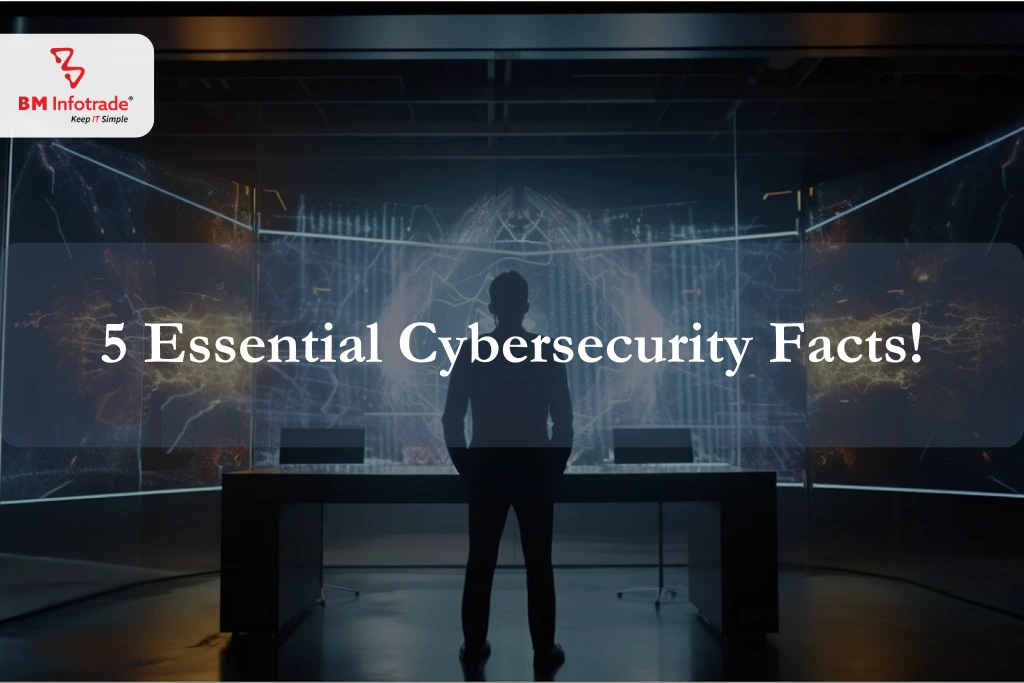5 Essential Cybersecurity Facts!
Five significant cybersecurity facts and statistics are highlighted in this article, highlighting the need to stay ahead of new online dangers.

5 Essential Cybersecurity Facts!
Table of Contents
- Cybersecurity Facts 1: An increase in cyberattacks
- Cybersecurity Facts 2: A Significant Cybersecurity Risk Is Human Error
- Cybersecurity Facts 3: Concern about Data Privacy Is Growing
- Cybersecurity Facts 4: Vulnerable Targets Are Internet of Things (IoT) Devices
- Cybersecurity Facts 5: Everyone Has a Part to Play in Cybersecurity
- In summary
Five significant cybersecurity facts and statistics are highlighted in this article, highlighting the need to stay ahead of new online dangers. Every statistic, from the rise in cyberattacks to the shared responsibility for cybersecurity, highlights a critical cybersecurity problem that individuals and institutions need to address.
The digital age has brought technology into our lives more and more. We utilize technology for social networking, online banking, cell phones, and smart homes as well as for communication and enjoyment. Concerns of digital reliance exist, including cybersecurity.
More than ever, careful digital stewardship is necessary in our connected world. Cybersecurity professionals, institutions, and users safeguard our digital infrastructure against malevolent actors who take advantage of weaknesses for their gain or malicious intent.
These results demonstrate that cybersecurity is a shared responsibility that calls for cooperation, learning, and ongoing threat adaptation. We can better safeguard ourselves and the internet by accepting this duty and knowing more.

Cybersecurity Facts 1: An increase in cyberattacks
Cyberattacks are becoming more frequent, complex, and lethal. Globally, people, companies, and governments are at risk due to significant data breaches and focused ransomware assaults.
Statistics and Trends
Cyberattacks are growing more common and powerful, according to recent studies. 40% more assaults were predicted by a leading cybersecurity firm for 2023. A concerning increase in cyberattacks across all industries was also discovered by the ITU Global Cybersecurity Index, underscoring the necessity for improved cybersecurity.
Typical Cyberattacks
Numerous vulnerabilities are exploited by malicious assaults. Typical cyberattacks:
Malware on computers: Data loss or damage.
Phishing: Obtaining financial information or passwords from targets.
Ransomware: An expensive kind of file or system encryption.
DDoS attacks: Sending a large volume of traffic to a website to bring it down.
Insider Threats: purposeful or unintentional harm done by employees.
Impact of Cyberattacks
Cyberatacks go beyond data theft and money. They might harm national and economic security by damaging infrastructure, consumer trust, and reputations. Cybersecurity becomes harder as IoT devices proliferate and increase the attack surface.
Read More:- Concepts of Cyber Security: Protecting Information
Cybersecurity Facts 2: A Significant Cybersecurity Risk Is Human Error
Technology has improved our digital skills, but human error has exacerbated cybersecurity dangers. Best practices, education, and awareness are crucial since human error causes most cybersecurity breaches, according to research.
An explanation of the human mistake
Human error in cybersecurity encompasses a variety of actions or omissions that endanger data or systems. Typical instances are:
Weak Passwords: Using well-known or predictable passwords that are easy for hackers to decipher.
Selecting dubious links: Customers are tricked into installing malware or disclosing personal information via phishing emails or websites.
Lack of Security Awareness: Inadequate knowledge of security measures failing to recognise threats or adhere to security regulations.
Configuration errors: Computers are vulnerable to exploitation when security settings are incorrect or software is outdated.
Human Mistakes That Lead to Breach
Human error has caused several high-profile cybersecurity breaches, underscoring its relevance. As an example:
Website flaws exposed almost 147 million people's data in the 2017 Equifax data breach.
WannaCry used a Windows vulnerability to infect hundreds of thousands of unpatched PCs worldwide.
Employee phishing assaults have damaged corporate networks and caused losses.
We Need Cybersecurity Instruction and Practice
Education and training are essential given the frequency and significance of human mistakes in cybersecurity breaches. Organisations may enable employees to protect themselves from cyber threats by educating them about common risks, modelling safe conduct, and fostering cybersecurity awareness.

Cybersecurity Facts 3: Concern about Data Privacy Is Growing
Widespread data collecting and utilisation have created privacy issues. Data sharing, storage, and protection on social networking and e-commerce sites are issues as digital footprints grow.
Importance of Data Privacy
Significance of Data Privacy Data privacy prevents illegal access, use, and disclosure of personal information. Securing sensitive data is necessary for the growth of digital transactions and online services to maintain privacy and confidence. Privacy is a digital human right since our browsing, financial, and health information online may disclose private information about us.
Dangers and Repercussions of Data Breach
Despite security precautions, data breaches continue to cause harm to both individuals and organisations. Sensitive information is revealed via data breaches, which may be dangerous:
Identity theft: Personal information stolen can open accounts or make unauthorised purchases.
Financial Loss: Credit card and banking data leaks can cost individuals and businesses.
Reputational Damage: Data breaches may make stakeholders, partners, and consumers doubt the firm.
Regulatory and Legal Repercussions: Data breaches and associated rules can result in legal penalties, fines, or regulatory implications for organisations that fail to secure sensitive data.
Laws and Adherence
Data privacy concerns have led to worldwide data protection and privacy policies. The GDPR requires consent, openness, and data subject rights for personal data handling. Californians now regulate how businesses collect and use their data thanks to the CCPA.
Cybersecurity Facts 4: Vulnerable Targets Are Internet of Things (IoT) Devices
Everything is easier and more efficient owing to the Internet of Things. In companies, homes, and public spaces, IoT devices are prevalent. Examples: fitness trackers and smart thermostats. IoT ecosystems require security because more gadgets are linked, which attracts thieves.
Definition of IoT Devices:
Internet-connected consumer gadgets, industrial sensors, and embedded systems are IoT devices. Data gathering, communication, and other activities improve healthcare, transportation, and smart city automation, monitoring, and control.
Dangers of Using Unsecured IoT Devices
IoT devices often include security vulnerabilities that hackers might take advantage of, despite their potential to revolutionise the industry. Unsecured IoT devices provide risks such as:
Privacy concerns: IoT devices may gather users' habits, interests, and behaviours.
Breach of network security: Cybercriminals can breach network security by using weak IoT devices to access home or corporate networks.
Physical safety risks: Transportation and healthcare IoT devices that are hacked or controlled may endanger public safety.
Botnet assaults: Cybercriminals can utilise vulnerable IoT devices to establish botnets for virus distribution or DDoS attacks.
Importance of Securing IoT Devices
Why IoT Device Security Is Important Both a technical and non-technical strategy is required for IoT device cybersecurity. To minimise vulnerabilities and prevent emerging threats, manufacturers need to include secure authentication, encryption, and software upgrades. To increase security, users should upgrade firmware, modify default passwords, and isolate vital equipment from IoT networks.
Cybersecurity Facts 5: Everyone Has a Part to Play in Cybersecurity
In the modern linked world, risk reduction, data protection, and cyberspace integrity maintenance need collaboration between individuals, businesses, and governments. According to this concept of shared responsibility, cybersecurity affects everyone and necessitates involvement, focus, and advancement across society.
The Model of Shared Responsibility
Cybersecurity shared responsibility requires consumers, corporations, and governments to protect digital assets and infrastructure. Here are some shared responsibility model ideas:
Individual Responsibilities: Users should update software, use strong passwords, and be cautious when disclosing personal information online.
Organisational Responsibilities: Businesses must secure networks, systems, and data from cyberattacks via intrusion detection systems, firewalls, and staff training.
Government Roles: Governments finance cybersecurity research, regulate it, and promote public-private collaboration to handle new threats and weaknesses.
Responsibilities
Each participant in the cybersecurity ecosystem is assigned a specific duty by the shared responsibility model:
People: People need to protect their data, stay safe from cyberattacks, and alert authorities to any questionable activity. By using appropriate cyber hygiene and being aware, one may lessen cyberattacks and increase the safety of the digital environment.
Organisations: Data on stakeholders, employees, and customers has to be protected. Included are risk assessments, human cybersecurity training, and cybersecurity awareness initiatives, as well as robust cybersecurity policies. Businesses that prioritise cybersecurity may reduce risks and increase confidence among partners and customers.
Governments: To hold firms accountable for data protection, governments must adopt and enforce cybersecurity legislation. Governments promote public-private cooperation, threat intelligence sharing, and cybersecurity financing to boost cyber resilience.
Cybersecurity is a Shared Responsibility
Stakeholder participation and information exchange speed cyber danger detection, appraisal, and mitigation. Sharing threat knowledge, best practices, and lessons may improve cybersecurity and adapt to evolving threats. An effective cybersecurity ecosystem includes international coordination, industry alliances, and public-private partnerships.
Read More:- The usefulness of VAPT in Cyber Security, Tools, and Testing.
In summary
Reviewing the basic facts of cybersecurity reveals that, despite its immense potential, the digital world nevertheless poses significant challenges. The cybersecurity landscape is dynamic and complex due to human error, cyberattacks, data privacy, IoT device susceptibility, and shared cybersecurity obligations.
More than ever, in a world that is always evolving, digital defenders are essential. Users, business executives, and public servants can safeguard cyberspace and our digital infrastructure. Collaboration, awareness, attention, and ongoing development might reduce cyberthreats and improve internet safety.





![Cloud Licensing and Compliance Made Easy [All-in-One Bundle]](https://bminfotrade.com/assets/upload/blog/21851766642757.png)

Anshul Goyal
Group BDM at B M Infotrade | 11+ years Experience | Business Consultancy | Providing solutions in Cyber Security, Data Analytics, Cloud Computing, Digitization, Data and AI | IT Sales Leader